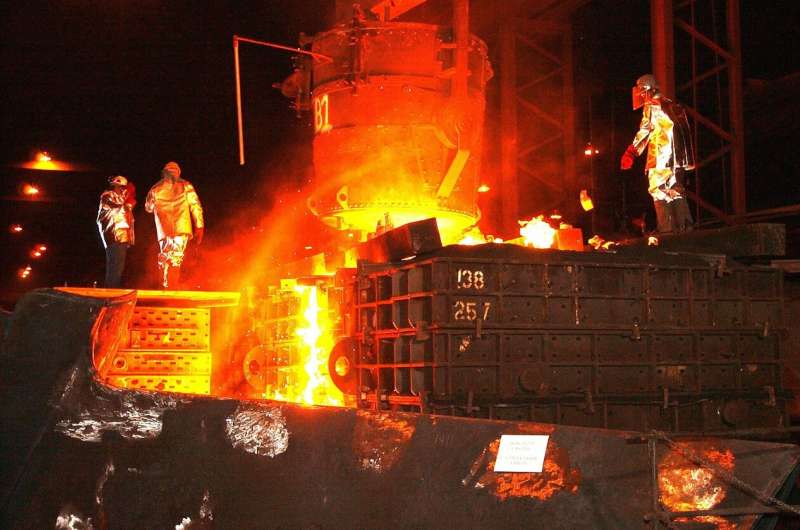From glass and steel to rare earth metals, new materials have changed society throughout history

Lisa Lock
scientific editor

Andrew Zinin
lead editor

Many modern devices—from cellphones and computers to electric vehicles and wind turbines—rely on strong magnets made from types of minerals called rare earths. As the systems and infrastructure used in daily life have turned digital and the United States has moved toward renewable energy, accessing these minerals has become critical—and the markets for these elements .
Modern society now uses rare earth magnets from national defense, where magnet-based systems are integral to missile guidance and aircraft, to , which depends on wind turbines and electric vehicles.
The rapid growth of the rare earth metal trade and its effects on society isn't the only case study of its kind. Throughout history, materials have quietly shaped the trajectory of human civilization. They form the tools people use, the buildings they inhabit, the devices that mediate their relationships and the systems that structure economies. Newly discovered materials can set off ripple effects that shape industries, shift geopolitical balances and transform people's daily habits.
is the study of the atomic structure, properties, processing and performance of materials. In many ways, materials science is a discipline of immense social consequence.
As a , I'm interested in what can happen when new materials become available. , and are all examples of how innovation in materials science has driven technological change and, as a result, shaped global economies, politics and the environment.
Glass lenses and the scientific revolution
In the early 13th century, after the , some excellent Byzantine glassmakers left their homes to settle in Venice—at the time a powerful economic and political center. The local nobility welcomed the glassmakers' beautiful wares. However, to prevent the glass furnaces from causing fires, the nobles exiled the glassmakers—under penalty of death—to the island of Murano.
Murano became a . In the 15th century, the glassmaker Angelo Barovier experimented with adding the ash from burned plants, which contained a chemical substance called potash, to the glass.
reduced the melting temperature and made liquid glass more fluid. It also eliminated bubbles in the glass and improved optical clarity. This transparent glass was later used in .
's printing press, completed in 1455, made reading more accessible to people across Europe. With it came a need for reading glasses, which grew popular among scholars, merchants and clergy—enough that spectacle-making became an .
By the early 17th century, glass lenses evolved into compound optical devices. Galileo Galilei , while discovered microbial life with a microscope.
have been transformative. Telescopes . in biology and medicine.
These changes marked the dawn of , where observation and measurement drove the creation of knowledge. Today, and the continue those early telescopes' legacies of knowledge creation.
Steel and empires
In the late 18th and 19th centuries, created demand for stronger, more reliable materials for machines, railroads, ships and infrastructure. The material that emerged , which is strong, durable and cheap. Steel is a mixture of mostly iron, with small amounts of carbon and other elements added.
Countries with large-scale steel manufacturing once had outsized economic and political power and influence over geopolitical decisions. For example, the British Parliament intended to prevent the colonies from exporting finished steel with the . They wanted the colonies' raw iron as supply for their steel industry in England.
invented a smelting process using 3-foot-tall ceramic vessels, called crucibles, in 18th-century Sheffield. Huntsman's produced higher-quality steel for tools and weapons.
One hundred years later, developed the , which drastically increased production speed and lowered costs. In the United States, figures such as created a vast industry based on Bessemer's process.
The widespread availability of steel transformed how societies built, traveled and defended themselves. Skyscrapers and transit systems made of steel allowed cities to grow, steel-built battleships and tanks empowered militaries, and cars containing steel became staples in consumer life.
Control over steel resources and infrastructure made steel a foundation of national power. China's 21st-century rise to steel dominance is a continuation of this pattern. From 1995 to 2015, China's contribution to the world from about 10% to more than 50%. The White House responded in 2018 with massive .
Rare earth metals and global trade
Early in the 21st century, the advance of digital technologies and the transition to an economy based on renewable energies created a demand for .
Rare earth elements are 17 chemically very similar elements, including , dysprosium, and others. They occur in nature in bundles and are the ingredients that make magnets super strong and useful. They are necessary for highly efficient electric motors, wind turbines and electronic devices.
Because of their chemical similarity, separating and purifying rare earth elements .
of global rare earth processing capacity. Political tensions between countries, and strategic competition, can risk shortages or disruptions in the supply chain.
The rare earth metals case illustrates how a single category of trade policy, industrial planning and even diplomatic alliances.
Technological transformation begins with societal pressure. New materials create opportunities for scientific and engineering breakthroughs. Once a material proves useful, it quickly becomes woven into the fabric of daily life and broader systems. With each innovation, the material world subtly reorganizes the social world—redefining what is possible, desirable and normal.
Understanding how societies respond to new innovations in materials science can help today's engineers and scientists solve crises in sustainability and security. Every technical decision is, in some ways, a cultural one, and every material has a story that extends far beyond its molecular structure.
Provided by The Conversation
This article is republished from under a Creative Commons license. Read the .![]()
















